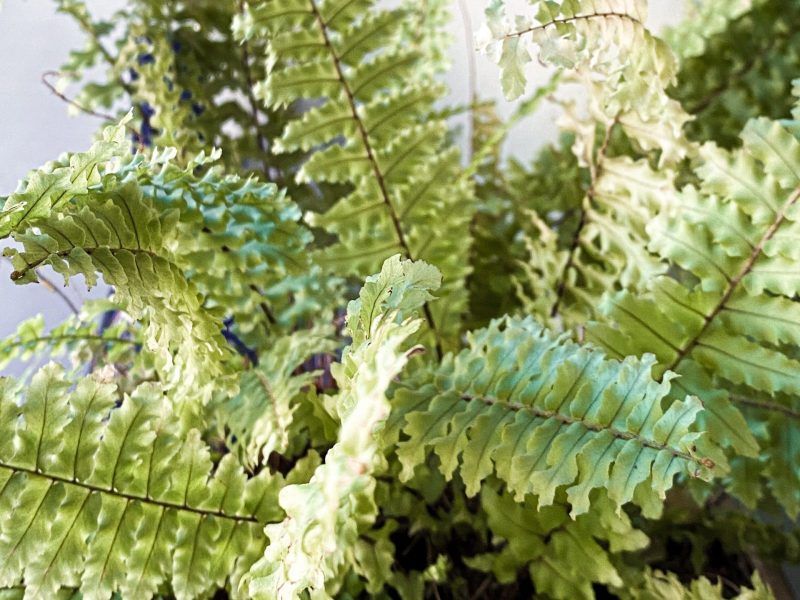
Boston Ferns bring a real bit of the wilderness into your home which is why we are so obsessed with them. However, it can be a little worrying if you notice your Fern is turning yellow as this is usually a sign that something is wrong. But you have come to the right place as below you will find all the common causes of yellow Boston Fern leaves!
Low humidity is normally the problem!
Boston Ferns love humidity, if you find that the leaves of your fern have turned yellow but not completely dry then this is probably the issue you’re facing. Raising the humidity for your houseplants is a pretty simple and straight forward process that shouldn’t take long for you to solve.
The first recommendation that we’d make is to spray your Boston Fern with a misting bottle every couple of days. This raises the local humidity around the plant and helps to maintain a more stable moisture level, we love these amber glass bottles from Amazon.
If that sounds like a bit too much work then you could also try out making a simple pebble tray. Using a dish or plastic tray, add a layer of gravel or small pebbles and pour over some water. Then you simply sit your plant on top, over time the water in the dish will evaporate and the humidity will start to raise.
Finally, the best and most effort free way of increasing the humidity is just to get yourself a small humidifier. Most homes have pretty dry air and one of these handy little gadgets will help fix that issue for good. We find these to be especially useful in the summer months when AC units are running, as they tend to dry out the air even more!
Keep the humidity high for your Boston Fern!

Overwatering can cause yellow leaves on your Boston Fern
If the soil becomes soggy and waterlogged for a long period of time, it will cause the roots to rot. This stops the plant being able to take up any water or nutrients from the soil and will turn the leaves yellow. They will also start to droop down and fall off if the plant is being overwatered.
You want to check the level of moisture in the soil before you make any changes to how you water your Boston Fern. Carefully lift the plant out of the pot and check if there is any damage to the root system. If the soil is waterlogged then we recommend replacing it immediately. You don’t want to wait for it to dry out naturally as you risk damaging the roots and fern even more.
Trim away the dead roots and leaves so your Fern can start to recover. It may take a few weeks before you see any sign of new growth as your Fern has gone through a lot. But over time, with the right amount of sunlight and warmth, your Boston Fern should be back to its full health – with no yellow leaves in sight!
If you’re finding it difficult to maintain good watering habits for your ferns, it might be worth looking into some other options that can make the whole process significantly easier.
Our first suggestion would be to make sure that the pots you’re using are allowing some of the excess moisture out of the soil.
This can be done in a couple of main ways. The first is by ensuring that you have drainage holes in the base of the inner pots, and that these drainage holes aren’t blocked by any large soil debris (this happens more than you might think!).
If that isn’t solving your problem then we would highly suggest investing in either self-watering or terracotta/ clay pots.
Self-watering pots (like these ones) offer a super easy way to get the correct moisture levels all of the time, and can also be great for holidays/ vacations when you’re not around to water your plants.
Terracotta or clay pots are fantastic because, unlike plastic pots, the materials they’re made of are permeable. This means that any of the excess moisture in the soil will wick through the sides of the pot and evaporate away.
Underwatering can also cause yellow leaves
If the leaves on your Boston Fern have gone quite yellow but dry, then too little water might be the issue. Again, you want to check the soil to make sure before increasing how much you water your Fern. If the soil is very powdery and dry then this is most probably the cause of the yellow leave. They like moisture in the soil so don’t let them dry out for long periods of time.
If your Boston Fern has been underwatered then slowly reintroduce watering over the next week or so. Going forward you want to make sure you are watering more than before to avoid the same problem happening again. Once you have trimmed away all of the dry crispy leaves you should start to see normal healthy green growth starting to come up. This is yet another place where a self watering pot can make your life so much easier!
Yellow leaves can indicate overfertilisation
Another common cause of yellow leaves in Boston Ferns is overfertilisation. Boston Ferns really don’t need much fertiliser and you can even skip it altogether. At most, you want to be fertilising a couple of times throughout the growth period of spring and summer and not at all during winter. If you are fertilising more than this then it could be the causes of the yellow leaves.
If you have been using slow-release fertiliser within the soil then remove the spikes or replace the potting mix if it is mixed in. If you have been using water-soluble fertiliser then it’s easier to solve as you just have to stop. Wait a few months before fertilising again (if at all). Trim away the worst affected leaves and over time the new growth should be relatively unaffected.
Pests can cause yellow leaves on your Boston Fern
Another rarer cause of yellow leaves on a Boston Fern is a pest infestation. Scale insects can cause yellow leaves on a Boston Fern so these are the ones to look out for if your plant is showing this symptom. Scale insects are quite a bit larger than some of the other main houseplant pests so are easier to spot and can be removed by picking them off the plant. We recommend also trimming off the worst affected plants to curb the infestation from growing quickly and then treating your Fern with neem oil. If the infestation hasn’t taken over your whole plant then these tricks should help stop the pests from killing your Fern.
Do yellow leaves mean my Boston Fern is dying?
Not at all! It does however mean that it isn’t liking something at the moment. Most of the time your Boston Fern can be saved from turning completely yellow by fixing the humidity and watering schedule.
The important thing is to start trying to fix the problem before it becomes big enough to kill the rest of the plant!
Can yellow Boston Fern leaves turn green again?
If the leaves are only starting to turn yellow and still have some green in them then it might not be too late!
However if they are completely yellow and starting to dry out then it might be time to trim them off and move one. Unfortunately those leaves won’t become green again.
Should I trim away the yellow leaves on my Boston Fern?
The simple answer is, yes!
Removing these yellow leaves will make sure that your plant isn’t trying hard sending nutrients to leaves that are already dying. This means that it can concentrate this energy on new growth.
Those are the most common reasons why a Boston Fern has yellow leaves. Act quickly once you know what the issue is as this will give your plant the best chance at bouncing back. If you want to learn more about how to care for your plant check out our Boston Fern care guide.














